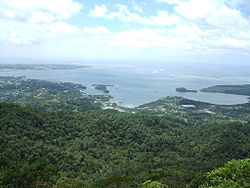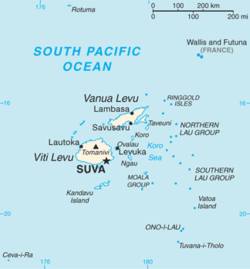Suva
Suva | |
|---|---|
 View of Suva’s industrial subdivision over looking the Suva Wharf | |
 Suva within Fiji | |
| Country | Fiji |
| Island | Viti Levu |
| Division | Central Division |
| Population (1996) | |
| • Total | 77,366 |
Suva is the capital and largest city of Fiji. It is located on the southeast coast of the island of Viti Levu, in the Central Division, of which it is the administrative center. In 1877, it was decided to make Suva the capital of Fiji when the geography of former main European settlement at Levuka on the island of Ovalau proved too restrictive. The administration of the colony was moved from Levuka to Suva in 1882. At the 1996 census, the last to date, the city of Suva had a population of 77,366 [1]. Including independent suburbs, the population of the Greater Suva urban area was 167,975 at the same census [2].
Physical characteristics
Suva is the commercial and political centre of Fiji, and the largest urban area in the South Pacific outside of Australia and New Zealand. It is Fiji's main port city.
Although Suva is on a peninsula, and almost surrounded by sea, the nearest beach is 40 kilometres (25 mi) away at Pacific Harbour, and the nearby coast is lined by mangroves. A significant part of the city centre, including the old Parliament Buildings, is built on reclaimed mangrove swamp.
Suva is noted for its considerable rainfall, it has a markedly higher rainfall than Nadi and the western side of Viti Levu, which is known to Suva citizens as "the burning west".
Landmarks
A well-known landmark is the Suva City Library, built in 1909.
The Government buildings complex sit in what was once the flowing waters of a creek. This was drained in 1935 and over five kilometres of reinforced concrete pilings were driven into the creek bed to support the massive buildings to be erected. After the foundation stone was laid in 1937, the building was completed in 1939; a new wing was completed in 1967. Parliament, however, was moved to a new complex on Ratu Sukuna Road in 1992.
Government House was formerly the residence of Fiji's colonial Governors and, following independence in 1970, Governors-General. It is now the official residence of Fiji's President. Originally erected in 1882, it had to be rebuilt in 1928, following its destruction by lightning in 1921.
The Suva campus of the University of the South Pacific (USP) occupies what was once a New Zealand military base. It is the largest of the many USP campuses dotted throughout the South Pacific.
The Fiji Museum, located in Thurston Gardens, was founded in 1904 and originally occupied the old town hall, but moved to its present location in 1954. The museum houses the most extensive collection of Fijian artifacts in the world, and is also a research and educational institution, specializing in archeology, the preservation of Fiji's oral tradition, and the publication of material on Fiji's language and culture.
Suva has around 78 parks, these include the new Takashi Suzuki Garden, Apted Park at Suva Point which is a popular spot for viewing sunrise and sunset, Thurston Gardens which was opened in 1913 and has flora from throughout the South Pacific.
Demographics of Suva
Suva is a multiracial and multicultural city. Indigenous Fijians and Indo-Fijians, the two principal ethnic groups of Fiji, comprise the bulk of Suva's population, but the city is also home to the majority of Fiji's ethnic minority populations, which include Caucasians and Chinese, amongst others. The majority of expatriates working in Fiji are also based in Suva. The most widely spoken language is English, but Fijian, Hindustani, and other Indian languages are also spoken by their respective communities.
Institutions
Suva is host to more international and regional intergovernmental agencies and NGOs than any other Pacific Island capital. Some of the bodies with a presence in Suva are:
- The TRAFFIC Oceania South Pacific Programme - funded by the UK Foreign and Commonwealth Office, is located in Suva, in the offices of the WWF South Pacific Programme. The programme assists in the implementation of CITES, but also strengthens collaboration with the World Wide Fund for Nature.
- The Fiji School of Medicine - which is now classed as a regional agency and a member of the Council of Regional Organisations in the Pacific
- The University of the South Pacific which operates a campus in Suva as well as at other South Pacific locations.
- The Secretariat of the Pacific Community (SPC)
- The Pacific Islands Forum Secretariat
- The South Pacific Applied Geoscience Commission.
- The Fulton Seventh Day Adventist College.
Municipal government
Suva has municipal status and is governed by a Lord Mayor and a 20-member city council, which is controlled by the Soqosoqo Duavata ni Lewenivanua following elections on 12 November 2005. The current Lord Mayor is Ratu Peni Volavola.
History

In return for a promise to pay off debts owed to the United States by the Bauan chieftain, Seru Epenisa Cakobau, the Australian-based Polynesia Company was granted 5000 km² of land, 575 km² of it near what was then the village of Suva, in 1868. The original intention was to develop a cotton farming industry, but the land and climate proved unsuitable.
Following the annexation of the Fiji Islands by the United Kingdom in 1874, the colonial authorities decided to move the capital to Suva from Levuka in 1877. The transfer was made official in 1882. Colonel F.E. Pratt of the Royal Engineers was appointed Surveyor-General in 1875 and designed the new capital, assisted by W. Stephens and Colonel R.W. Stewart.
Following the promulgation of the Municipal Constitution Ordinance of 1909, Suva acquired municipal status in 1910. The town initially comprised one square mile; these boundaries remained intact until 1952 when the Muanikau and Samabula wards were annexed, expanding its territory to 13 square kilometers. In October that year, Suva was proclaimed a City - Fiji's first. Tamavua was subsequently annexed; the most recent extension of the city boundaries has been to incorporate the Cunningham area to the north of the city. Urban sprawl has resulted in a number of suburbs that remain outside of the city limits; together with the city itself, they form a metropolitan area known as the Greater Suva Area.
The city hosted the 2003 South Pacific Games, being the third time in the event's 40 year history that they had been held in Suva. As part of the hosting of the event a new gymnasium and indoor sports center, swimming pool and stadium, field hockey pitch and stands were built in the area around Suva, funded by the government and a $16 million People's Republic of China aid package[3].
Transportation
Nausori International Airport caters mainly for the domestic Market but can cater for smaller international aircraft it also services its immediate pacific neighbors such as Tuvalu and Tonga.
Hall of Fame
This is a list of famous people currently living, or are from Suva.
- Joffrey Zinedine, Columbia Inferno (ECHL) right winger
References
- Fiji, by Korina Miller, Robyn Jones, Leonardo Pinheiro - Travel - 2003, published by Lonely Planet, pages 139-141, details on Suva City.
- The Suva City Library: A Brief History and Development, 1909-1980, by S Baksh - 1980
- Pluralism and Social Change in Suva City, Fiji, by Alexander Mamak - 1974, Thesis/dissertation; Ethnology (Fiji, Suva City); Suva City, Fiji Islands (Social conditions)
- A History of the Pacific Islands: Passages Through Tropical Time - Page 162, by Deryck Scarr 2001 - 323 pages.
- Frommer's South Pacific, by Bill Goodwin - Travel - 2004, pages 258-263
External links
- Template:Wikitravel
- My Wiki City: Suva, Fiji - Suva demographics, climate info, and schools at My Wiki City.
- Suva City Council (official website)
